Amelia Ann Blanford Edwards (1831-1892)
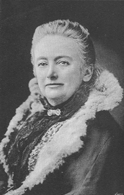
| Biography | Bibliography |
Biography:
Anyone who has lost themselves in one of Elizabeth Peters' "Amelia Peabody" mysteries, daydreaming of high adventure amid the pyramids of Egypt, will be intrigued by the writings of her real-life contemporary Amelia Edwards. Edwards enjoyed three separate careers: as an journalist, a novelist, and an egyptologist. She was also an active supporter of the suffrage movement, serving at one time as Vice-President of the Society for Promoting Women's Suffrage. Unlike the fictional Amelia Peabody, Amelia Edwards never married, but lived and travelled for much of her life with a female companion.
Amelia Edwards was born in 1831 in London. Her father had been an army officer before becoming a banker. Her mother was Irish. Amelia was educated at home by her mother, and showed promise as a writer at a very young age. Her first published poem appeared at age 7; her first published story, at age 12. Amelia published poetry, stories, and articles in a number of magazines including Chamber's Journal, Dicken's Household Words and All the Year Round. She also wrote for the newspapers, the Saturday Review and the Morning Post. Several of her short pieces can be read on-line at Gaslight.
Her first full-length novel was My Brother's Wife (1855). Her early novels were well received, but it was Barbara's History (1864), a novel of bigamy, that solidly established her reputation as a novelist. She spent considerable time and effort on their settings and backgrounds, estimating that it took her about two years to complete the researching and writing of each one. One might be set in America, another in England, a third in France. This painstaking work paid off. Her last novel, Lord Brackenbury (1880), was a run-away success which went to 15 editions.
Yet it is not her novels that are reprinted nowadays, but her traveller's tales. At age 30, following the death of her parents, Amelia had little reason to stay in England. Nor was there anyone close to her who would criticize if she chose to travel. The proceeds of her writings were sufficient to enable her to live independently and go where she wished. Amelia embarked on a series of intrepid expeditions, of which she wrote. Her accounts are notable for her knowledge of her surroundings, her interest and openness towards the people and customs of other countries, and not least for the humour and enthusiasm which enliven many of her experiences.
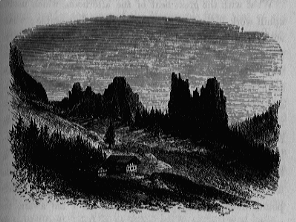
At a time when male chaperonage was considered socially, if not physically, essential for a woman traveller, she chose to travel and live with a woman companion. Male servants or guides were hired as needed, but in no way controlled the journeys. Their first trip was chronicled as Sights and Stories: A Holiday Tour Through Northern Belgium (1862). A challenging journey through the Dolomites, a mountainous area almost unknown to tourists at that time, is recounted in Untrodden Peaks and Unfrequented Valleys (1873). In the introduction, Edwards warns her readers,
"The passages are too long and too fatiguing for ladies on foot, and should not be attempted by any who cannot endure eight and sometimes ten hours of mule-riding." (Untrodden Peaks and Unfrequented Valleys, 1873, p. xxxiii.)
Together the two women braved flies, mud, cold, heat, poor roads (or no roads at all), resistant or hostile male servants and villagers, and other difficulties and privations. They thoroughly enjoyed themselves. It is clear that part of the attraction of travelling, for Edwards, was the challenge of reaching areas that were almost entirely untouched and inaccessible; of meeting and overcoming difficulties that others would not face. She sounds delighted when she states:
"We journeyed sometimes for days altogether without meeting a single traveller either in the inns or on the roads, and encountered only three parties of English during the whole time" (Untrodden Peaks and Unfrequented Valleys, 1873, p. xxxiv.)
It was her third documented journey, however, that substantially changed the direction of Edwards' life. In 1870, she travelled to Egypt and sailed a dahabiyeh up the Nile to Abu Simbel. There, she spent six weeks excavating at the Temple of Rameses II. Her animated and engaging account of the trip was published as A Thousand Miles Up the Nile in 1877. Of setting off the first day, in their boat, the Philae, she writes:
"Happy are the Nile travellers who start thus with a fair breeze on a brilliant afternoon. The good boat cleaves her way swiftly and steadily. Water-side palaces and gardens glide by, and are left behind. The domes and minarets of Cairo drop quickly out of sight. The mosque of the citadel, and the ruined fort that looks down upon it from the mountain ridge above, diminish in the distance. The Pyramids stand up sharp and clear." (A Thousand Miles Up the Nile 1891 edition, p. 37.)
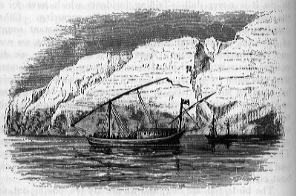
By the end of the trip, Amelia was entirely smitten with Egyptology. It would become the major work of the rest of her life. All the same, the initial realization that intriguing artifacts were quarried from the graves of the dead was a shock. She writes of the changing perceptions of herself and others:
"Shocked at first, they denounce with horror the whole system of sepulchral excavation, legal as well as predatory; acquiring, however, a taste for scarabs and funerary statuettes, they soon begin to buy with eagerness the spoils of the dead; finally, they forget all their former scruples, and ask no better fortune than to discover and confiscate a tomb for themselves. " (A Thousand Miles Up the Nile 1891 edition, pp. 51-52.)
Trade in antiquities was largely illegal, and lucrative. There was tension and colonial rivalry between French and English explorers. The political climate was unstable. Once found, a site would almost certainly be pillaged and destroyed by the knowledgeable, the greedy, and the random passer-by. Edwards writes with regret:
... the wall-paintings which we had the happiness of admiring in all their beauty and freshness, are already much injured. Such is the fate of every Egyptian monument, great or small. The tourist carves it all over with names and dates, and in some instances with caricatures. The student of Egyptology, by taking wet paper "squeezes," sponges away every vestige of the original colour. The "collector" buys and carries off everything of value that he can get; and the Arab steals for him. The work of destruction, meanwhile, goes on apace. There is no one to prevent it; there is no one to discourage it. Every day, more inscriptions are mutilated—more paintings and sculptures are defaced. ... When science leads the way, is it wonderful that ignorance should follow? (A Thousand Miles Up the Nile, 1891 edition, pp. 353.)
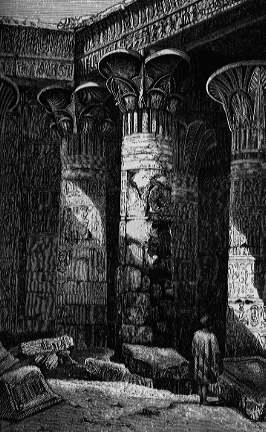
Yet science offered the hope of recording and preserving something of that beauty and history rather than losing it utterly. Scientific investigations might lead to understanding, not just accumulation of treasure. When she returned to England, Edwards was determined to promote the cause of Egyptian archaeology. The field of Egyptology was just beginning to professionalize: many of those involved were "gentlemen explorers" whose technical expertise and knowledge varied widely. In such a climate, a rare gentlewoman might also become involved. Edwards consulted with leading experts, educated herself about the field, and formed lasting friendships with young gifted men such as Maspero and Flinders Petrie.
With her expertise in journalism, Edwards was well-placed to arouse public interest in supporting excavation work. With Reginald Poole, she began planning and promoting the founding of an Egyptological Society. It met for the first time in June 1880, at the British Museum. In 1882 it became formally known as the Egypt Exploration Fund, with Amelia Edwards and Reginald Poole as its joint honorary secretaries. While Poole took over the internal administration, Edwards attended to publicity and subscription work. Through the unceasing dedication of both Poole and Edwards, the society was soon able to finance the exploration work of Flinders Petrie. There is no question that the sound financial status of the Egypt Exploration Fund was largely a result of her extensive campaigning.
Edwards wrote letters soliciting possible supporters, and campaigned for the society by undertaking strenuous lecture tours through England and the United States. A series of such lectures were rewritten and published in book form, as Pharaohs, Fellahs, and Explorers in 1891. Edwards' personality sparkles through the pages. In Chapter 8, she chooses to describe in detail a Queen of Egypt, Hatasu, dissenting from other Egyptologists who minimized her importance. Edwards' love and knowledge of Egyptology are ably demonstrated in this collection. It also gives some idea of her ability to communicate clearly and interestingly to an audience. Edwards also translated a number of works into English, including Maspero's Egyptian Archaeology. She completely gave up her successful career as a novelist, writing only on Egyptological matters after 1880.
Her work was generally respected. She received three honourary degrees:, from Columbia College, New York; Smith College, Massachusetts; and the College of the Sisters of Bethany, also in Massachusetts. She also received an English civil list pension for "her services to literature and archaeology."

However, as the field of archaeology increasingly became the province of professional males, her influence in the policies and direction of the Egypt Exploration Fund decreased. More and more, de facto decisions were made by a sub-committee at the British Museum, in which she was not included, rather than by the Executive Committee of which she was part. Her marginalization was possible partly because so much of her time was spent away from London, campaigning on behalf of the society. Flinders Petrie, who unsuccessfully complained about the change to Poole, was to state flatly in his memoirs: "Poole and Newton cut out the founder, Miss Edwards."
Although saddened, Amelia continued to dedicate herself to the Egypt Exploration Fund. Her happiest and most productive period, however, was over. Her health began to deteriorate after the breaking of an arm during a lecture tour in American, in 1889-1890. Her enthusiasm did not decrease, but her energy did. Then, in January 1892, she suffered a personal loss: the death of the woman who had travelled with her and shared her West Country home for nearly thirty years. On April 15 of that year, Amelia too died, the immediate cause of her death being severe influenza.
She left an extensive library of Egyptology and a collection of Egyptian antiquities to University College, London. With it went a bequest of 2,500 pounds, to establish the first English chair in Egyptology. She would have been happy to know that, in accordance with her wishes, her friend and colleague Flinders Petrie was appointed to the position. The rest of her library was given to Somerville College, an early women's college at Oxford.
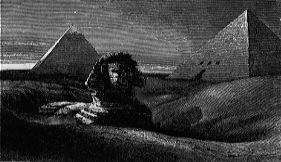
Bibliography:
Novels
My Brother's Wife 1855.
Barbara's History 1864.
Debenham's Vow 1870.
The Days of My Youth 1873.
Lord Brackenbury 1880.
The Ladder of Life
Hand and Glove
Half a Million of Money
Miss Carew
Monsieur Maurice
The phantom coach by Amelia B. Edwards; adapted by I.M. Richardson, illustrated by Hal Ashmead. c.1982.
Poetry
Ballads. New York: Carleton,18--.
A poetry-book of elder poets, consisting of songs & sonnets, odes & lyrics, selected and arranged, with notes, from the works of the elder English poets, dating from the beginning of the fourteenth century to the middle of the eighteenth century. 1878.
Travel
Sights and Stories: A Holiday Tour Through Northern Belgium. 1862.
Untrodden Peaks and Unfrequented Valleys: A Midsummer Ramble in the Dolomites. London: Longman's, Green, and Co. 1873.
History and Archæology
Pharaohs, Fellahs, and Explorers New York: Harper & Brothers, 1891.
A Thousand Miles Up the Nile London: George Routledge and Sons, Limited, 1891.
The Story of Cervantes
Outlines of English history : from the Roman conquest to the present time : with observations on the progress of art, science, and civilization, and questions adapted to each paragraph : for the use of schools c.1857.
Translations
Manual of Egyptian archaeology and guide to the study of antiquities in Egypt : for the use of students and travellers by Sir G. Maspero. Translated by Amelia B. Edwards.